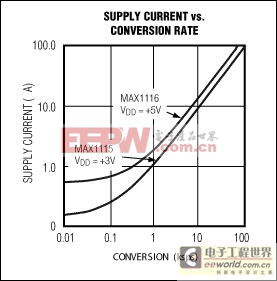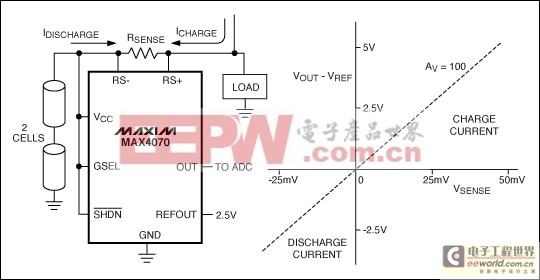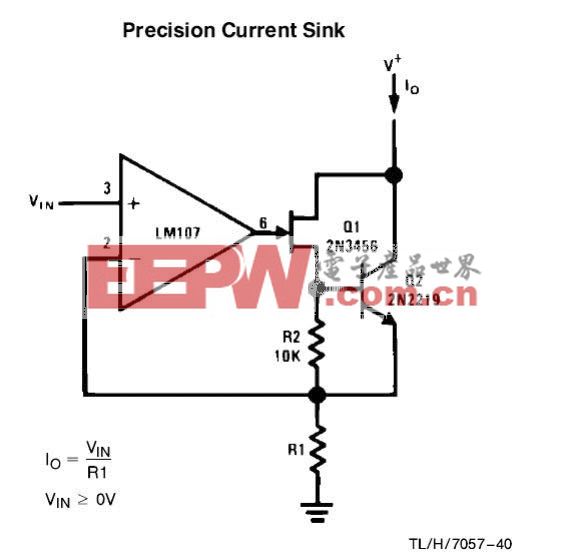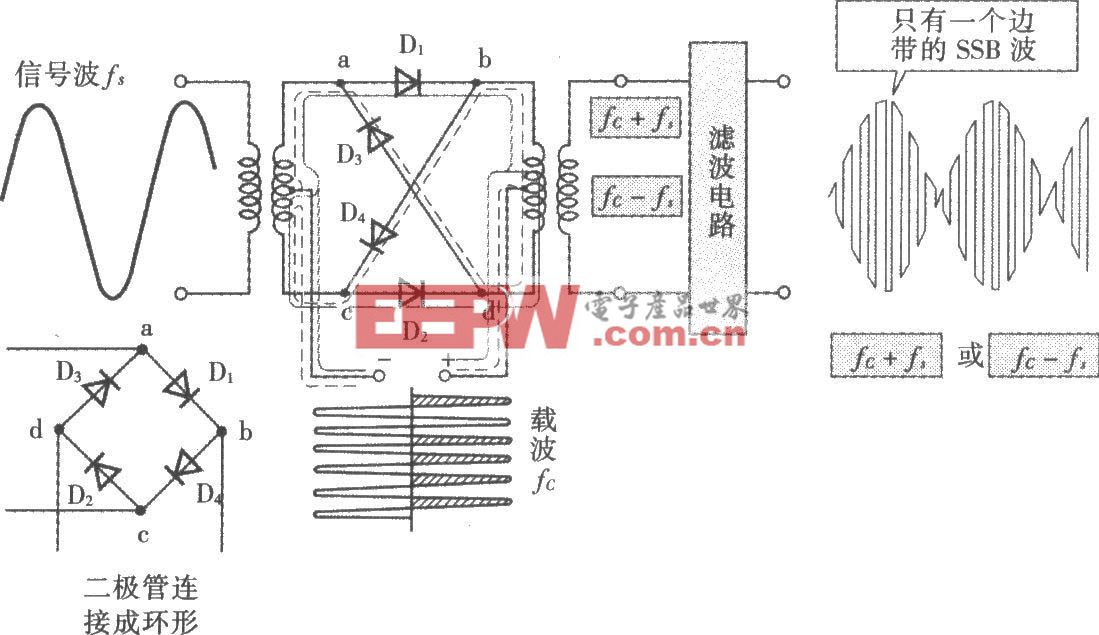模擬集成電路的低電壓系統(tǒng)-Analog ICs for Lo
The MAX1115, for example, converts 100k samples per second. It operates from a +3V supply using only 175μA of operating current, and uses just 1μA of current in automatic power-down mode. The MAX1115 offers a large power savings for applications in which the sampling is intermittent (Figure 5).

Figure 5. By entering a 1μA power-down mode between conversions, the MAX1115 8-bit ADC offers a dramatic reduction in supply current.
One such application is the measurement of received signal strength in cellular telephones (RSSI: received signal-strength indicator). The MAX1115 digitizes the signal at 2ksps, while drawing a mere 2μA from the 3V supply. Total unadjusted error (the sum of offset, integral nonlinearity, and gain errors) less than 1 LSB and SINAD (signal-to-noise and distortion) less than 48dB are guaranteed.
D/A Converters
Modern D/A converters (DACs) allow low-voltage digital systems to generate analog outputs. Intended for portable applications, these ICs require very little power and board area. The low-cost MAX5811, for instance, is a 10-bit, voltage-output DAC with low 170μA operating current and just 1μA shutdown current, which is ideal for portable applications. Its serial-data control allows it to fit into a SOT23 package.The MAX5811 operates from single 2.7V supply, and its output swings rail-to-rail. It is ideal for low-cost applications such as trimming offset voltages, setting the bias point for adjustable current (or voltage) sources, and setting the regulation point in other circuits.
Op Amps and Current Monitors
In op amps, reduced-supply operation reduces the signal-to-noise ratio (SNR) by curtailing the output-voltage swing. Many low-voltage op amps, therefore, offer rail-to-rail output swings as a means of preserving the SNR. For the same reason, many feature an input-voltage range that includes one or both supply rails.Low-voltage operation not only reduces the signal range, it puts an additional squeeze on SNR by raising the noise floor. Low-voltage amplifiers are often designed to draw low supply current, which leads to higher levels of amplifier noise. In addition, the feedback resistors have higher values (to limit system supply currents), which also adds noise.
To further complicate matters, high-impedance nodes are more likely to pick up noise from high-speed digital signals through capacitive coupling. Therefore, high-impedance traces should be kept short and physically distant from high-speed digital traces.
Noteworthy, and somewhat mutually exclusive, low-voltage op amp features include low supply current, low offset voltage, and high speed. The MAX4236A +3V series of devices, for example, combine a 1.7MHz gain-bandwidth product and 20μV offset voltage with a low 350μA supply current. Input common-mode voltage range is down to the negative rail, and the outputs swing rail-to-rail. These characteristics make the MAX4236A series of op amps useful as instrumentation amplifiers in low-voltage, battery-powered systems.
Maxim's op amp family also features bidirectional, high-side current-sense amplifiers, such as the +2.7V MAX4069 series (Figure 6). These current-sense amplifiers minimize grounding problems by employing high-side, current-sense resistors and come in 8-/10-pin μMAX? packages.

Figure 6. The MAX4070 bidirectional current-sense amplifier forms a complete current-to-voltage converter.
For portable applications that must conserve every microamp, some low-voltage, micropower op amps offer remarkably low supply currents. The +1.4V MAX4036/MAX4038 and +1.8V MAX4474 op amps offer extremely low power consumption at 1.2μA (max). Outputs are rail-to-rail, and input ranges include the negative rail.
Input common-mode voltage range and output voltage swing typically become squeezed when powering op amps from low-voltage supplies. Care must be taken to observe these input and output limits when designing low-voltage circuits. Table 3 presents a cross section of data for the op amps discussed above.
Table 3. A Selection of Specifications for Some of Maxim's Low-Voltage Op Amps
| Part | Supply Voltage Range (V) | Supply Current (μA, typ/max) | Input Common-Mode Voltage Range (V) | Output-Voltage Swing (V, typ) |
| MAX4036/MAX4038 | 1.4 to 3.6 | 0.8/1.2 | VSS to (VDD - 0.4) | (VSS + 0.002) to (VDD - 0.002) |
| MAX4069 | 2.7 to 24 | 100/250 | 1.35 to 24 | (VSS + 0.1) to (VDD - 0.09) |
| MAX4070 | 3.6 to 24 | 100/250 | 1.35 to 24 | (VSS + 0.1) to (VDD - 0.09) |
| MAX4236A | 2.4 to 5.5 | 350/440 | -0.15 to (VCC - 1.2) | (VEE + 0.05) to (VCC - 0.15) |
| MAX4474 | 1.8 to 5.5 | 0.75/1.2 | VSS to (VDD - 1.1) | (VSS + 0.001) to (VDD - 0.004) |
Comparators
Like low-voltage op amps, low-voltage comparators include products separately optimized for high speed, low supply current, and low offset voltage. The MAX910DIY機(jī)械鍵盤相關(guān)社區(qū):機(jī)械鍵盤DIY









評(píng)論